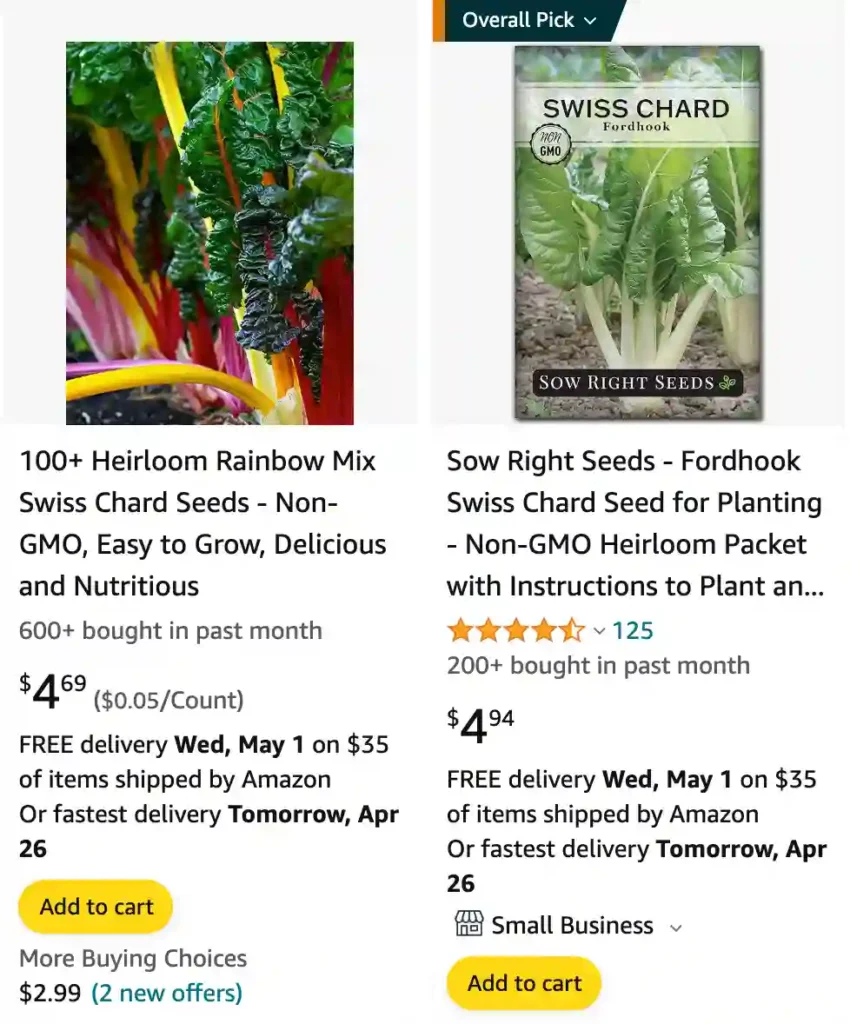
Can you eat Swiss chard raw?
Absolutely, I love eating Swiss chard raw! The leaves add a nice, fresh crunch to salads, and I find them a bit less bitter than some other salad greens like kale. I like to use the colorful varieties, like rainbow chard, in salads – their bright colors make the dish really pop. Sometimes, I just take a few of the smaller, tender leaves for a quick, healthy snack. Of course, Swiss chard is delicious cooked too, but there’s something so satisfying about its fresh, crisp texture raw.
How to store Swiss chard?
Storing Swiss chard properly is key to keeping it fresh. I always remove any rubber bands or ties and give the leaves a quick rinse if there’s any dirt. Then, I pat them dry (moisture leads to spoilage!) and loosely wrap them in a slightly damp paper towel. Then they go into a plastic bag – I usually leave it partially open – and into the crisper drawer of my fridge. Stored this way, my Swiss chard stays fresh and crisp for several days, sometimes up to a week if I’m lucky!
Can dogs eat Swiss chard?
Yes, dogs can eat Swiss chard, but it’s best to serve it cooked. Cooking gets rid of most of the oxalates, which can be a bit harsh for their digestive system. My dog actually seems to love cooked Swiss chard! I sometimes mix it into her regular food as an extra boost of vegetables and fiber. A little bit goes a long way though; I stick to small amounts to avoid any tummy troubles.
Can you eat Swiss chard stems?
Absolutely! I used to just focus on the leaves, but then I realized how much I was wasting. The stems are a bit tougher, so the key is giving them extra cooking time. I like to slice them and saute them with a little olive oil, garlic, and a pinch of salt until they’re tender. The stems add a nice, slightly sweet, and earthy flavor to dishes. Sometimes I’ll even throw them into stir-fries or soups for an extra bit of texture and nutrition.
Can bearded dragons eat Swiss chard?
Unfortunately, Swiss chard isn’t the best choice for bearded dragons. It’s high in oxalates, which can bind to calcium and make it difficult for them to absorb. This can lead to health problems over time. Though I know it can be tempting to offer your beardie a variety of greens, it’s always better to stick with safer options like collard greens, dandelion greens, or turnip greens. These are lower in oxalates and provide a better nutritional balance for your scaly friend.
Can chickens eat Swiss chard?
Yes, chickens can eat Swiss chard, and they usually seem to love it! My chickens gobble it up whenever I offer it to them. I like to tear up the leaves and stems into smaller pieces, so they’re easier to peck at. Swiss chard is a good source of vitamins and minerals for them. However, it’s important to offer it in moderation since it does contain oxalates. As with most treats, it’s best to keep it as a small part of a varied and balanced diet.
How to cut Swiss chard?
Cutting Swiss chard is pretty straightforward once you get the hang of it. I usually start by rinsing the leaves under cold water to remove any dirt or debris. Then, I lay the leaves flat on a cutting board and use a sharp knife to remove the stems. I find that folding the leaves in half lengthwise makes it easier to cut along the stem. After that, I chop the leaves into smaller pieces, depending on how I plan to use them. Sometimes, if I’m making a salad, I’ll chop them into bite-sized pieces, but if I’m adding them to a stew or sauté, I might leave them a bit larger. Overall, it’s all about finding a technique that works for you and practicing until you feel comfortable with it.
Can bunnies eat Swiss chard?
Bunnies can definitely enjoy Swiss chard as part of their diet, but like with any new food, it’s important to introduce it gradually. I’ve found that my bunnies really like Swiss chard because it’s leafy and has a nice crunch to it. However, I always make sure to wash it thoroughly to remove any pesticides or dirt that might be on it. I also avoid feeding them the stems, as they can be a bit tough for their delicate digestive systems. Instead, I stick to feeding them the leafy greens, which they seem to enjoy nibbling on throughout the day. As with any new food, it’s always a good idea to monitor their reaction and make sure they don’t have any adverse effects.
Can guinea pigs eat Swiss chard?
Guinea pigs can definitely eat Swiss chard, and it’s actually a great addition to their diet because it’s packed with vitamins and minerals. When I introduced Swiss chard to my guinea pigs, I started by giving them small amounts to see how they reacted. Thankfully, they took to it quite well and seemed to really enjoy munching on the leafy greens. I always make sure to thoroughly wash the Swiss chard before giving it to them, and I avoid giving them the stems, as they can be a bit tough for their sensitive digestive systems. Overall, Swiss chard is a nutritious and tasty treat that I’m happy to include in their diet rotation.
Is Swiss chard the same as rhubarb?
Swiss chard and rhubarb are actually quite different, both in terms of appearance and taste. Swiss chard is a leafy green vegetable with vibrant, colorful stems and large, glossy leaves. It’s often used in salads, stir-fries, and soups, and has a slightly earthy flavor. On the other hand, rhubarb is a perennial vegetable with long, thick stalks that are typically red or green in color. Rhubarb is known for its tart flavor and is commonly used in desserts, jams, and sauces. While both Swiss chard and rhubarb are nutritious, they have distinct tastes and are used in different culinary applications.
Is Swiss chard a perennial?
Swiss chard is actually a biennial plant, meaning it typically completes its life cycle in two years. However, it is often grown as an annual in gardens because it is harvested for its leaves in the first year of growth before it flowers and sets seed. In some regions with mild winters, Swiss chard may overwinter and continue to produce leaves in the second year, behaving somewhat like a perennial. However, it is not strictly classified as a perennial plant.
Can Swiss chard be frozen?
Yes, Swiss chard can be frozen, and it’s a great way to preserve it if you have a surplus or want to save it for later use. Personally, I’ve found that blanching Swiss chard before freezing helps maintain its color, texture, and flavor. To do this, I start by washing the Swiss chard thoroughly and removing any tough stems. Then, I bring a large pot of water to a boil and blanch the Swiss chard leaves for about 2 minutes. After blanching, I quickly transfer the leaves to an ice bath to stop the cooking process. Once cooled, I pat them dry and portion them into freezer-safe bags or containers before placing them in the freezer. When I’m ready to use the frozen Swiss chard, I simply thaw it in the refrigerator or add it directly to soups, stews, or stir-fries. It’s a convenient way to enjoy Swiss chard year-round!
What not to plant with Swiss chard?
When planting Swiss chard, it’s important to consider companion planting to promote healthy growth and prevent any potential issues. One thing to avoid planting near Swiss chard is members of the Brassica family, such as cabbage, broccoli, and cauliflower. These plants can attract similar pests and diseases, which may spread to the Swiss chard. Additionally, planting Swiss chard near aromatic herbs like basil or sage can deter pests and enhance its flavor. I’ve found that planning out my garden layout with companion planting in mind has helped create a harmonious environment for all my plants to thrive.
Can i juice Swiss chard?
Absolutely, you can juice Swiss chard! In fact, Swiss chard is a popular ingredient in many green juice recipes because of its vibrant color and nutrient-rich profile. When juicing Swiss chard, I typically include both the leaves and stems for maximum nutrition. However, I make sure to thoroughly wash the Swiss chard beforehand to remove any dirt or debris. I find that combining Swiss chard with other fruits and vegetables like apples, cucumbers, and lemons can help balance its slightly bitter flavor. Juicing Swiss chard is a great way to incorporate more greens into your diet and enjoy its health benefits in a refreshing and convenient form.
What meat goes well with Swiss chard?
Swiss chard pairs well with a variety of meats, but I particularly enjoy it with lighter options like grilled chicken or fish. The mild flavor of these proteins complements the slightly earthy taste of Swiss chard without overpowering it. I’ve also found that lean cuts of pork, such as pork tenderloin or chops, work nicely with Swiss chard, especially when seasoned with herbs like rosemary or thyme. For a heartier meal, I sometimes opt for roasted lamb or turkey alongside a side of sautéed Swiss chard with garlic and olive oil. Ultimately, the versatility of Swiss chard allows for creative pairings with a wide range of meats to suit various tastes and preferences.
What to plant with Swiss chard?
When planning what to plant alongside Swiss chard, it’s beneficial to consider companion planting to promote healthy growth and deter pests. Some great companion plants for Swiss chard include:
- Herbs like basil, cilantro, and dill: These aromatic herbs can help repel pests and attract beneficial insects while enhancing the flavor of Swiss chard dishes.
- Root vegetables such as carrots and beets: Swiss chard’s shallow roots make it compatible with deeper-rooted vegetables like carrots and beets, which can help improve soil structure and nutrient uptake.
- Brassicas like kale and cabbage: While it’s generally advised to avoid planting members of the Brassica family near Swiss chard, kale can be a suitable companion as it has similar growing requirements and complements Swiss chard in salads and stir-fries.
- Legumes like beans and peas: Legumes are nitrogen-fixing plants that can enrich the soil with nitrogen, benefiting the growth of Swiss chard and other nearby vegetables.
- Flowers like marigolds and nasturtiums: These colorful flowers not only add beauty to the garden but also help repel pests and attract pollinators, contributing to a healthier growing environment for Swiss chard.
By incorporating these companion plants into your garden alongside Swiss chard, you can create a balanced and thriving ecosystem while maximizing your harvest.
When to start Swiss chard seeds indoors?
Swiss chard is a cool-season crop that can tolerate a light frost, making it suitable for early planting. If you want to start Swiss chard seeds indoors, you can typically do so about 4 to 6 weeks before the last expected frost date in your area. This allows the seedlings to develop a strong root system before transplanting them outdoors once the weather warms up. In regions with mild winters, you may also choose to sow Swiss chard seeds directly into the garden in early spring or late summer for a fall harvest. However, if you’re starting seeds indoors, providing adequate light, warmth, and moisture will help ensure successful germination and healthy seedling growth.
Where can i buy Swiss chard?
Swiss chard is commonly available for purchase at various places, depending on your location and preferences. You can find Swiss chard at:
- Grocery stores: Most grocery stores carry fresh produce, including Swiss chard. You can typically find it in the vegetable section alongside other leafy greens.
- Farmers’ markets: Local farmers’ markets are great places to buy fresh, locally grown Swiss chard. You can support local farmers while also enjoying the freshest produce available.
- Specialty markets: Some specialty markets or health food stores may carry organic or specialty varieties of Swiss chard, offering a wider selection for those seeking specific options.
- Online retailers: Many online retailers offer the convenience of ordering Swiss chard from the comfort of your home and having it delivered to your doorstep. This can be particularly convenient if you have difficulty finding it locally or prefer the convenience of online shopping.
Regardless of where you choose to buy Swiss chard, look for crisp, vibrant leaves and avoid any that appear wilted or discolored. Enjoy incorporating this nutritious and versatile leafy green into your meals!
Can goats eat Swiss chard?
While goats can consume a wide variety of plants, including many types of leafy greens, Swiss chard should be fed to them in moderation and with caution. Swiss chard contains oxalic acid, which can bind to calcium and potentially lead to the formation of kidney stones or other health issues in goats if consumed in large quantities. Additionally, some goats may find the taste of Swiss chard unpalatable compared to other greens. It’s important to introduce new foods slowly and monitor your goats for any signs of digestive upset or adverse reactions. As with any dietary changes, consulting with a veterinarian or experienced goat owner is recommended to ensure the health and well-being of your goats.
How many Swiss chard per square foot?
The number of Swiss chard plants you can grow per square foot depends on various factors such as the variety of Swiss chard, growing conditions, and your desired spacing. As a general guideline, you can plant Swiss chard about 4 to 6 inches apart in rows spaced 12 to 18 inches apart.
In terms of square foot gardening, which typically involves intensive planting in raised beds or containers, you can plant Swiss chard more densely. Some square foot gardening resources suggest planting 4 Swiss chard plants per square foot. However, this can vary based on personal preference and the specific growing conditions in your garden. It’s essential to provide adequate space for each plant to grow and access to sunlight, water, and nutrients to ensure healthy development. Adjusting plant spacing based on the size and vigor of your Swiss chard plants as they grow is also recommended.
How to boil Swiss chard?
Boiling Swiss chard is a simple and delicious way to prepare this nutritious leafy green. Here’s how I do it:
- Start by rinsing the Swiss chard leaves thoroughly under cold water to remove any dirt or debris. Trim off any tough stems, if desired.
- Bring a pot of water to a boil on the stove. Make sure the pot is large enough to accommodate the Swiss chard without overcrowding.
- Once the water is boiling, add the Swiss chard leaves to the pot. You may need to work in batches if you have a lot of Swiss chard.
- Let the Swiss chard boil for about 2 to 3 minutes, or until the leaves are tender but still bright green. Be careful not to overcook them, as they can become mushy.
- Using tongs or a slotted spoon, remove the Swiss chard from the boiling water and transfer it to a bowl of ice water. This will stop the cooking process and help preserve the bright color of the leaves.
- Drain the Swiss chard well and squeeze out any excess water. You can now use the boiled Swiss chard in a variety of dishes, such as soups, stews, salads, or as a simple side dish seasoned with olive oil, garlic, and lemon juice.
Boiling Swiss chard is a quick and easy cooking method that helps retain its flavor and nutrients. Experiment with different seasonings and serving options to find your favorite way to enjoy this versatile leafy green!
How to can Swiss chard?
Canning Swiss chard is a great way to preserve this nutritious leafy green for long-term storage. Here’s a basic guide on how to can Swiss chard:
- Prepare the Swiss chard: Start by washing the Swiss chard leaves thoroughly under cold water to remove any dirt or debris. Trim off any tough stems and chop the leaves into smaller pieces, if desired.
- Blanch the Swiss chard: Bring a large pot of water to a boil on the stove. Blanch the Swiss chard leaves in boiling water for about 2 minutes, then quickly transfer them to a bowl of ice water to stop the cooking process. Drain the Swiss chard well and squeeze out any excess water.
- Prepare the canning jars: Sterilize your canning jars and lids according to the manufacturer’s instructions. Keep the jars and lids hot until ready to use.
- Pack the Swiss chard into jars: Pack the blanched Swiss chard tightly into the hot, sterilized canning jars, leaving about 1 inch of headspace at the top of each jar.
- Add liquid: If desired, you can add a small amount of boiling water or vegetable broth to the jars to help cover the Swiss chard and enhance flavor. Be sure to leave the appropriate amount of headspace in the jars.
- Remove air bubbles: Use a clean, non-metallic utensil, such as a plastic spatula or chopstick, to remove any air bubbles from the jars by running it around the edges of the Swiss chard.
- Seal the jars: Wipe the rims of the jars with a clean, damp cloth to remove any residue. Place the lids on the jars and screw on the bands until they are fingertip tight.
- Process the jars: Place the filled jars in a boiling water canner or pressure canner, ensuring that they are covered with at least 1 to 2 inches of water. Process the jars according to the recommended processing time and pressure for your altitude and canner type.
- Cool and store: Once the processing time is complete, carefully remove the jars from the canner and place them on a towel-lined countertop to cool completely. As they cool, you should hear the lids make a popping sound, indicating that they have sealed properly. Store the sealed jars in a cool, dark place for up to 1 year.
Canning Swiss chard is a great way to enjoy this nutritious vegetable year-round. Be sure to follow proper canning procedures and guidelines to ensure safe and successful preservation.
How to cook Swiss chard and kale?
Cooking Swiss chard and kale together can create a delicious and nutritious dish. Here’s a simple recipe:
Ingredients:
- 1 bunch Swiss chard
- 1 bunch kale
- 2 cloves garlic, minced
- 2 tablespoons olive oil
- Salt and pepper to taste
- Optional: red pepper flakes, lemon juice, grated Parmesan cheese
Instructions:
- Wash the Swiss chard and kale thoroughly under cold water. Trim off any tough stems from both the Swiss chard and kale leaves, then chop them into bite-sized pieces.
- Heat the olive oil in a large skillet or frying pan over medium heat. Add the minced garlic and sauté for about 1 minute, or until fragrant.
- Add the chopped Swiss chard and kale to the skillet, working in batches if necessary to avoid overcrowding. Cook, stirring occasionally, until the greens begin to wilt and become tender, about 5-7 minutes.
- Season the greens with salt, pepper, and any additional seasonings you like, such as red pepper flakes for a bit of heat or a squeeze of lemon juice for brightness.
- Once the Swiss chard and kale are cooked to your liking, remove them from the heat and transfer to a serving dish.
- Optional: Sprinkle grated Parmesan cheese over the cooked Swiss chard and kale for added flavor.
- Serve the cooked Swiss chard and kale as a side dish alongside your favorite protein, or incorporate them into other recipes like omelets, pasta dishes, or grain bowls.
This simple cooking method brings out the natural flavors of Swiss chard and kale while preserving their vibrant colors and nutritional benefits. Feel free to customize the seasoning and add other ingredients to suit your taste preferences!
How to grow Swiss chard in containers?
Growing Swiss chard in containers is a great option for those with limited space or who prefer the convenience of gardening on a patio, balcony, or deck. Here’s a guide on how to grow Swiss chard in containers:
- Choose the right container: Select a container that is at least 8-12 inches deep and has drainage holes in the bottom to allow excess water to escape. Larger containers will accommodate more Swiss chard plants and provide room for their roots to spread.
- Fill the container with potting mix: Use a high-quality potting mix that is well-draining and nutrient-rich. Fill the container to within a few inches of the top, leaving space to plant the Swiss chard seeds or seedlings.
- Plant Swiss chard seeds or seedlings: If starting from seeds, sow them directly into the container according to the recommended spacing on the seed packet, usually about 1 inch apart. If using seedlings, gently transplant them into the container, spacing them evenly.
- Water thoroughly: After planting, water the Swiss chard seeds or seedlings well to ensure the soil is evenly moist. Water regularly to keep the soil consistently moist but not waterlogged, especially during hot, dry weather.
- Provide adequate sunlight: Place the container in a location that receives at least 6-8 hours of sunlight per day. Swiss chard prefers full sun but can tolerate partial shade, especially in hotter climates.
- Fertilize as needed: Swiss chard is a relatively low-maintenance plant, but you can fertilize it with a balanced fertilizer or organic compost every few weeks to promote healthy growth. Follow the instructions on the fertilizer package for application rates.
- Harvest regularly: As the Swiss chard plants grow, harvest the outer leaves regularly to encourage continuous production. Use sharp scissors or garden shears to cut the leaves from the base of the plant, leaving the inner leaves to continue growing.
- Watch for pests and diseases: Keep an eye out for common pests such as aphids, caterpillars, and slugs, and treat them promptly if detected. Also, monitor the plants for signs of disease, such as yellowing or wilting leaves, and take appropriate measures to prevent the spread.
By following these steps, you can successfully grow Swiss chard in containers and enjoy a fresh supply of nutritious greens throughout the growing season.
If i die, water my plants!



